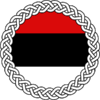Káragur
 | This article or section is out of date. A country/countries relevant to this article have been removed from Sahar and have been retconned. Not everything here may still be considered canonical. This article was last edited by Jute (talk | contribs) 3 years ago. (Update) |
Káragur | |
|---|---|
| Nickname(s): Sortjekámm Sorteic City | |
| Motto(s): Kámm Hanjenápjap City of Confederation | |
| Country | Sorteic |
| Region | Śahdanśa |
| Subregion | Lopgah |
| Canton | Káragur |
| Government | |
| • Grand Mayor | Name Namesson |
| Population (2016) | |
| • Total | 1,125,026 |
| Demonym(s) | Káraguran |
| Time zone | UTCnot observed (Glorp Mean Time) |
| • Summer (DST) | UTC+0 (+0) |
| Postal code | KÁ2000-KÁ2999 |
| Municipal code | KÁ-KÁM |
Káragur (Sortjecjan: Káragur [ka:ɾaguɾ]) is the capital of Sorteic, as well as its second largest city. Káragur is also the capital of Káragur Canton, a Sortjecjan-majority canton in the centre of Sorteic. In 2016, the municipal area had a population of 1,125,026. The municipal area is within what is known as the Twenty Four, named for the 24 municipalities of Káragur. The larger area of Káragur covers the majority of the Canton of Káragur, with much of it being suburban or loosely connected town localities.
Káragur was founded as a small Tienndu settlement in pre-Letsatian times. It is unlikely that it was ever a major city before the independence of the Cantons. During the pre-Confederal era, Káragur would become a centre of learning, political enlightenment and military theory, causing it to become an important member of the confederation. Though the capital changed places with each meeting of the League Diet, Káragur was only once chosen to be the meeting place of the confederation, due to a tense rivalry it possessed with some of the more southerly Cantons, both Sortjecjan and Lestzi.
Káragur became the official capital of the Sortein Confederation after the Public House War, which concluded with the eponymous Treaty of Káragur, a document which, in an edited form, would become the constitution of the Confederation. The renovation of the city's central districts in the mid-18th Century created many important sites of Sortein governance, as well as numerous tourist and commemorative destinations, making the whole district a much less populated and more legislative base.
The city is serviced by two airports, two rail networks (the state-run above-ground rail system called the Kárakjarhan, and the privately-owned underground system, collectively known as the Gahan), a bus system, consisting of tourist buses and regular transport buses, a tram line running through the city's legislative district and CBD, numerous independent taxi services and a number of cable cars which take people to high points in the city. The city has numerous tourist sites, generally focused along the Central District and CBD, but with some in the older and more traditional portions of the city also.
Etymology
History
Geography
Climate
Cityscape
Culture
Economy
Government
Demographics
International relations
- Out of date
- Articles with short description
- Pages using infobox settlement with possible nickname list
- Pages using infobox settlement with possible motto list
- Pages using infobox settlement with unknown parameters
- Pages using infobox settlement with no map
- Pages using infobox settlement with no coordinates
- Sorteic

